
Illustrative Math Alignment: Grade 6 Unit 9
Putting it All Together
Lesson 3: Rectangle Madness
Use the following Media4Math resources with this Illustrative Math lesson.
| Thumbnail Image | Title | Body | Curriculum Topics |
|---|---|---|---|
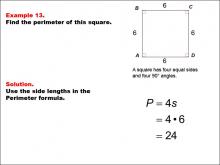
|
Math Example--Area and Perimeter--Quadrilaterals: Example 13 | Math Example--Area and Perimeter--Quadrilaterals: Example 13TopicGeometry DescriptionThis example demonstrates how to calculate the perimeter of a square. The square ABCD has sides measuring 6 units each. To find the perimeter, we use the formula P = 4s, where s is the length of a side. In this case, P = 4 × 6 = 24 units. |
Area and Perimeter of Quadrilaterals |
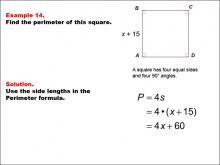
|
Math Example--Area and Perimeter--Quadrilaterals: Example 14 | Math Example--Area and Perimeter--Quadrilaterals: Example 14TopicGeometry DescriptionThis example illustrates the calculation of a square's perimeter using an algebraic expression. The square ABCD has sides measuring x + 15 units. To find the perimeter, we use the formula P = 4s, where s is the side length. In this case, P = 4(x + 15) = 4x + 60 units. Incorporating algebra into geometry problems helps students connect different mathematical concepts and develop more advanced problem-solving skills. This collection of examples bridges the gap between basic geometry and algebraic thinking, preparing students for more complex mathematical challenges they will encounter in higher-level courses. |
Area and Perimeter of Quadrilaterals |
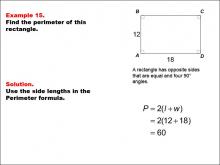
|
Math Example--Area and Perimeter--Quadrilaterals: Example 15 | Math Example--Area and Perimeter--Quadrilaterals: Example 15TopicGeometry DescriptionThis example demonstrates how to calculate the perimeter of a rectangle. The rectangle ABCD has a length of 18 units and a width of 12 units. To find the perimeter, we use the formula P = 2(l + w), where l is the length and w is the width. In this case, P = 2(18 + 12) = 2(30) = 60 units. |
Area and Perimeter of Quadrilaterals |
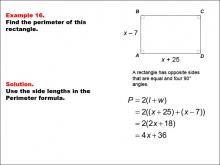
|
Math Example--Area and Perimeter--Quadrilaterals: Example 16 | Math Example--Area and Perimeter--Quadrilaterals: Example 16TopicGeometry DescriptionThis example demonstrates the calculation of a rectangle's perimeter using algebraic expressions. The rectangle ABCD has a length of x + 25 units and a width of x - 7 units. To find the perimeter, we use the formula P = 2(l + w), where l is the length and w is the width. In this case, P = 2[(x + 25) + (x - 7)] = 2(2x + 18) = 4x + 36 units. |
Area and Perimeter of Quadrilaterals |
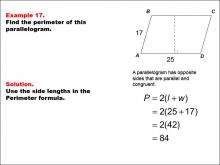
|
Math Example--Area and Perimeter--Quadrilaterals: Example 17 | Math Example--Area and Perimeter--Quadrilaterals: Example 17TopicGeometry DescriptionThis example illustrates how to calculate the perimeter of a parallelogram. The parallelogram ABCD has side lengths of 17 units and 25 units. To find the perimeter, we use the formula P = 2(l + w), where l and w are the lengths of the two different sides. In this case, P = 2(17 + 25) = 2(42) = 84 units. |
Area and Perimeter of Quadrilaterals |
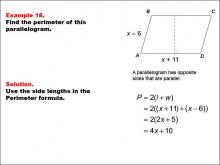
|
Math Example--Area and Perimeter--Quadrilaterals: Example 18 | Math Example--Area and Perimeter--Quadrilaterals: Example 18TopicGeometry DescriptionThis example demonstrates the calculation of a parallelogram's perimeter using algebraic expressions. The parallelogram ABCD has side lengths of x + 11 units and x - 6 units. To find the perimeter, we use the formula P = 2(l + w), where l and w are the lengths of the two different sides. In this case, P = 2[(x + 11) + (x - 6)] = 2(2x + 5) = 4x + 10 units. |
Area and Perimeter of Quadrilaterals |
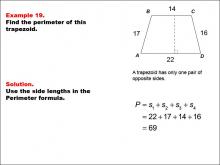
|
Math Example--Area and Perimeter--Quadrilaterals: Example 19 | Math Example--Area and Perimeter--Quadrilaterals: Example 19TopicGeometry DescriptionThis example demonstrates how to calculate the perimeter of a trapezoid. The trapezoid ABCD has sides measuring 22, 17, 14, and 16 units. To find the perimeter, we simply add all four side lengths. In this case, P = 22 + 17 + 14 + 16 = 69 units. |
Area and Perimeter of Quadrilaterals |
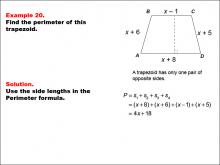
|
Math Example--Area and Perimeter--Quadrilaterals: Example 20 | Math Example--Area and Perimeter--Quadrilaterals: Example 20TopicGeometry DescriptionThis example illustrates the calculation of a trapezoid's perimeter using algebraic expressions. The trapezoid ABCD has sides measuring x + 8, x + 6, x - 1, and x + 5 units. To find the perimeter, we add all four side lengths. In this case, P = (x + 8) + (x + 6) + (x - 1) + (x + 5) = 4x + 18 units. |
Area and Perimeter of Quadrilaterals |
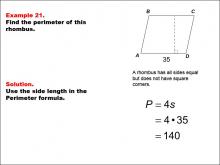
|
Math Example--Area and Perimeter--Quadrilaterals: Example 21 | Math Example--Area and Perimeter--Quadrilaterals: Example 21TopicGeometry DescriptionThis example demonstrates how to calculate the perimeter of a rhombus. The rhombus ABCD has all sides measuring 35 units. To find the perimeter, we use the formula P = 4s, where s is the length of a side. In this case, P = 4 × 35 = 140 units. |
Area and Perimeter of Quadrilaterals |
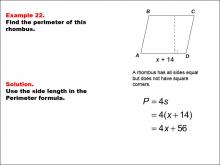
|
Math Example--Area and Perimeter--Quadrilaterals: Example 22 | Math Example--Area and Perimeter--Quadrilaterals: Example 22TopicGeometry DescriptionThis example illustrates the calculation of a rhombus's perimeter using an algebraic expression. The rhombus ABCD has all sides measuring x + 14 units. To find the perimeter, we use the formula P = 4s, where s is the side length. In this case, P = 4(x + 14) = 4x + 56 units. |
Area and Perimeter of Quadrilaterals |
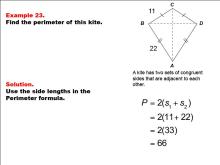
|
Math Example--Area and Perimeter--Quadrilaterals: Example 23 | Math Example--Area and Perimeter--Quadrilaterals: Example 23TopicGeometry DescriptionThis example demonstrates how to calculate the perimeter of a kite. The kite ABCD has two pairs of equal sides: AB and AD measure 22 units each, while BC and CD measure 11 units each. To find the perimeter, we add all four side lengths. In this case, P = 22 + 22 + 11 + 11 = 66 units. |
Area and Perimeter of Quadrilaterals |
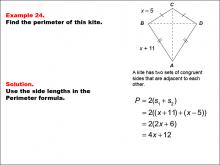
|
Math Example--Area and Perimeter--Quadrilaterals: Example 24 | Math Example--Area and Perimeter--Quadrilaterals: Example 24TopicGeometry DescriptionThis example illustrates the calculation of a kite's perimeter using algebraic expressions. The kite ABCD has two pairs of equal sides: AB and AD measure x + 11 units each, while BC and CD measure x - 5 units each. To find the perimeter, we add all four side lengths. In this case, P = (x + 11) + (x + 11) + (x - 5) + (x - 5) = 4x + 12 units. |
Area and Perimeter of Quadrilaterals |
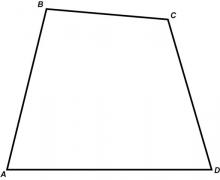
|
Math Clip Art--Geometry Concepts--Quadrilaterals--Generic Quadrilateral | Math Clip Art--Quadrilaterals--Generic QuadrilateralTopicGeometry Concepts DescriptionThis image illustrates a generic quadrilateral, a four-sided polygon with no specific properties regarding side lengths or angles. Quadrilaterals are a fundamental shape in geometry, and their properties can vary widely. Understanding generic quadrilaterals is crucial for exploring the properties of more specific types, such as squares, rectangles, and trapezoids. They serve as a basis for studying angles, side lengths, and symmetry in polygons. |
Definition of a Quadrilateral |

|
Math Clip Art--Geometry Concepts--Quadrilaterals--Rectangle | Math Clip Art--Quadrilaterals--RectangleTopicGeometry Concepts DescriptionThis image depicts a rectangle, a quadrilateral with opposite sides that are equal and parallel, and four right angles. Rectangles are a specific type of quadrilateral with symmetrical properties and are widely used in design and architecture. Understanding rectangles involves exploring properties such as area, perimeter, and symmetry. They are used in various mathematical contexts to study parallel lines, congruence, and transformations. |
Definition of a Quadrilateral |
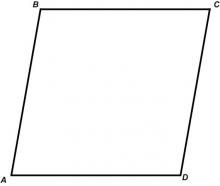
|
Math Clip Art--Geometry Concepts--Quadrilaterals--Rhombus | Math Clip Art--Quadrilaterals--RhombusTopicGeometry Concepts DescriptionThis image features a rhombus, a quadrilateral with all sides equal in length and opposite angles equal. Rhombuses are a specific type of parallelogram with unique symmetrical properties. Understanding rhombuses involves exploring properties such as area, perimeter, and symmetry. They are used in various mathematical contexts to study congruence, transformations, and tiling patterns. Teacher's Script: "Examine this rhombus. How do its properties, such as equal sides and opposite angles, help us understand its geometry? What are some mathematical concepts you can explore using rhombuses, such as symmetry or transformations?" |
Definition of a Quadrilateral |
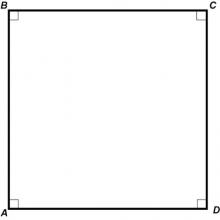
|
Math Clip Art--Geometry Concepts--Quadrilaterals--Square | Math Clip Art--Quadrilaterals--SquareTopicGeometry Concepts DescriptionThis image depicts a square, a quadrilateral with all sides equal and all angles equal to 90 degrees. Squares are a specific type of rectangle and rhombus, known for their perfect symmetry and balance. Understanding squares involves exploring properties such as area, perimeter, and symmetry. They are used in various mathematical contexts to study congruence, transformations, and tiling patterns. Teacher's Script: "Look at this square. How do its properties, such as equal sides and right angles, help us understand its geometry? What are some real-world applications of squares, such as in design or architecture?" |
Definition of a Quadrilateral |

|
Definition--Quadrilateral Concepts--Kite | KiteTopicQuadrilaterals DefinitionA kite is a quadrilateral with two distinct pairs of adjacent sides that are equal. DescriptionKites are unique geometric figures that play a significant role in both theoretical and applied mathematics. The properties of kites are utilized in real-world applications, such as in design and computer graphics. Moreover, understanding kites enhances students' grasp of more advanced geometric properties and relationships, making this concept highly relevant in math education. |
Definition of a Quadrilateral |
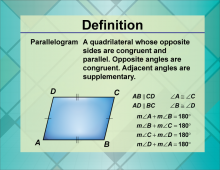
|
Definition--Quadrilateral Concepts--Parallelogram | ParallelogramTopicQuadrilaterals DefinitionA parallelogram is a quadrilateral with opposite sides that are equal and parallel. DescriptionParallelograms hold significant importance in both theoretical and applied mathematics. They are observed in various real-world situations such as architecture and engineering designs. Understanding the properties of parallelograms forms a foundation for more complex geometric concepts that students will encounter in their education, which highlights their relevance in mathematics teaching. |
Definition of a Quadrilateral |

|
Definition--Quadrilateral Concepts--Quadrilateral | QuadrilateralTopicQuadrilaterals DefinitionA quadrilateral is a four-sided polygon characterized by its vertices and edges. DescriptionQuadrilaterals are foundational shapes in geometry that underpin more advanced concepts. Utilizing quadrilaterals in both theoretical models and real-world applications, such as in architecture and design, exemplifies their significance. Grasping the properties of quadrilaterals helps students build essential reasoning skills necessary in various fields of math and science, emphasizing the need for a strong understanding of geometric principles. |
Definition of a Quadrilateral |
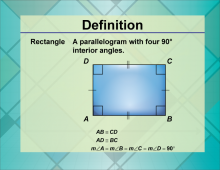
|
Definition--Quadrilateral Concepts--Rectangle | RectangleTopicQuadrilaterals DefinitionA rectangle is a quadrilateral with opposite sides equal and four right angles. DescriptionRectangles are one of the most common geometric shapes, greatly used across different domains including art, architecture, and various forms of design. Understanding the properties and applications of rectangles is crucial in math education as they form a basis for learning about more complex geometric shapes. Mastery of rectangles allows students to develop spatial understanding and problem-solving skills needed for more advanced math topics. |
Definition of a Quadrilateral |
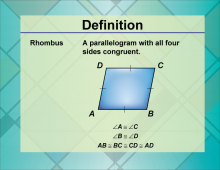
|
Definition--Quadrilateral Concepts--Rhombus | RhombusTopicQuadrilaterals DefinitionA rhombus is a quadrilateral with all sides equal in length. DescriptionThe rhombus, with its unique properties, serves as an integral concept in geometry. Its applications span design and manufacturing industries, where equal lengths are essential. Assuring that students understand the rhombus furthers their grasp of geometric properties and relationships, underpinning more advanced learning in mathematics education. |
Definition of a Quadrilateral |
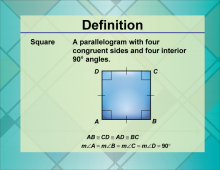
|
Definition--Quadrilateral Concepts--Square | SquareTopicQuadrilaterals DefinitionA square is a quadrilateral with all four sides of equal length and all four angles equal to 90 degrees. |
Definition of a Quadrilateral |
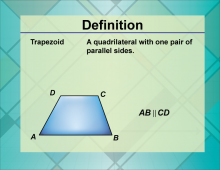
|
Definition--Quadrilateral Concepts--Trapezoid | TrapezoidTopicQuadrilaterals DefinitionA trapezoid is a quadrilateral with at least one pair of parallel sides. DescriptionThe trapezoid is a versatile geometric shape with applications in various fields such as architecture, engineering, and art. Its defining feature is having one pair of parallel sides, which makes it useful for creating structures and designs that require stability and balance. Understanding trapezoids helps students grasp the concept of parallelism and its implications in geometry. This knowledge is vital for solving real-world problems and enhances students' overall mathematical proficiency. |
Definition of a Quadrilateral |
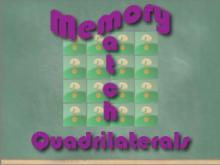
|
Interactive Math Game--Memory Game: Quadrilaterals | Interactive Math Game--Memory Game: Quadrilaterals
Use this math game to review quadrilaterals. This is a Memory-style game in which students must remember the location of pairs of identical images. This is part of a collection of math games and interactives. To see the complete collection of the games, click on this link. Note: The download is the teacher's guide.Related ResourcesTo see additional resources on this topic, click on the Related Resources tab. |
Definition of a Quadrilateral |
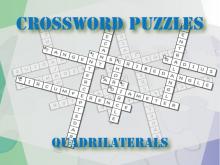
|
Interactive Crossword Puzzle--Quadrilaterals | Interactive Crossword Puzzle--Quadrilaterals
This interactive crossword puzzle tests knowledge of key terms on the topic of quadrilaterals. This is part of a collection of math games and interactives. To see the complete collection of the games, click on this link. Note: The download is the teacher's guide.Related ResourcesTo see additional resources on this topic, click on the Related Resources tab. |
Definition of a Quadrilateral |
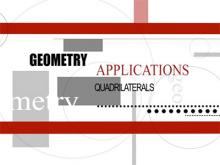
|
VIDEO: Geometry Applications: Quadrilaterals | VIDEO: Geometry Applications: Quadrilaterals
TopicQuadrilaterals |
Applications of Quadrilaterals |
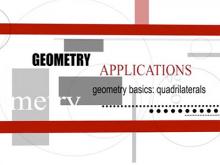
|
VIDEO: Geometry Applications: Quadrilaterals, 1 | VIDEO: Geometry Applications: Quadrilaterals, 1
TopicQuadrilaterals DescriptionDescription: Quadrilaterals are fundamental in structural design, as seen in examples like Stonehenge and home layouts. Their prevalence in construction stems from properties like parallel sides and stability, making them ideal for creating functional spaces. |
Applications of Quadrilaterals |

|
VIDEO: Geometry Applications: Quadrilaterals, 2 | VIDEO: Geometry Applications: Quadrilaterals, 2
TopicQuadrilaterals DescriptionDescription: This segment examines quadrilaterals in modern architecture, such as Frank Lloyd Wright’s Fallingwater. It explores how rectangles derive stability and maximum area from right triangles, offering applications in both aesthetic and structural design. |
Applications of Quadrilaterals |
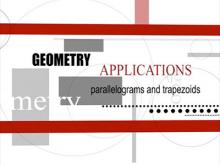
|
VIDEO: Geometry Applications: Quadrilaterals, 3 | VIDEO: Geometry Applications: Quadrilaterals, 3
TopicQuadrilaterals DescriptionDescription: Focused on tilted parallelograms in architecture, such as Madrid’s Puerta de Europa towers, this segment discusses balance, center of gravity, and how slanted shapes maintain stability. Applications include structural engineering and innovative design. |
Applications of Quadrilaterals |